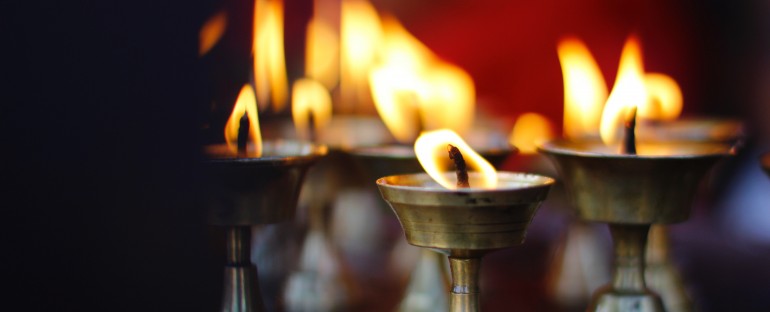The temples we visited in India are infused with centuries of ritual—prayers, mantras, and fire ceremonies–performed by holy people. The power generated through continuous repetition of the rituals was palpable as we entered these sacred spaces. But we don’t have to go anywhere to access the benefit of ritual in our daily lives. Creating a personal altar is one way. Although our home altars have not been blessed by centuries of ceremonies, we can infuse them, on a daily basis, with our heartfelt intentions for healing, growth or anything we wish to bring into our lives. In this way our nervous system is primed to receive the grace that is always available.
One of my colleagues at hospice set up an altar in her office to honor her clients’ loved ones who had died. Seeing the pictures on Mary’s altar when they came in for their session gave her clients a sense of connection and a feeling that others acknowledged the life of the person they had lost. It also gave them the sense they were not alone in their grief. We all partake in loss by virtue of being human. We are all connected in this aspect of our shared humanity. Although this realization doesn’t take away the grief, we no longer feel so alone when we have experienced loss.
At hospice, we often suggested that our clients create an altar at home to help facilitate the grieving process. When my client, Diane was healing from the loss of her twin, Marie (not their real names), she told me that sitting in front of her altar every morning gave her a sense of peace. The altar was simple—a small table with a picture of herself and Marie as young children hugging each other, a wooden box, a single candle, and a beautiful crystal. She had created a ritual: Sitting at the altar every morning before going to work, she would light the candle, read something inspirational, and write a brief note to Marie, which she would place in the wooden box. This simple ritual had the power to carry her through the day. Diane looked forward to her morning ritual, knowing she would feel better when sitting at her altar. In this way, the altar gained a sort of power.
For an altar to be effective, it must be seen as sacred, whether or not you are spiritual or religious. To me, sacred means it is dedicated to a certain purpose, it is held with special regard, respected, honored as something beyond our mundane, ordinary life. An altar can be used to convey our respect, our desires, our gratitude to something beyond our limited ego-selves. And gratitude opens us to receive more fully the grace that is always present. The altar can be empowered so that when we connect with it, we feel in tune with the Infinite, we transcend our everyday life. It has the power to pull us into the now—the only place we are fully alive. When Diane sat at her altar every morning, she entered the present, which is the only place she could connect with Marie. Although she had memories of her twin from the past, she could feel Marie’s presence and fully commune with her here and now when sitting at her altar.
Activating the altar by placing on it objects or pictures that represent to us something beyond our own limitations gives it power. Rituals such as lighting candles and incense can express a sense of reverence and sacredness that uplift our spirit. And as with any ritual, over time, connecting with our altar with reverence can change the neuronal connections in our brains in a beneficial way. It can enhance our ability to be present in our everyday lives.
Stu and I recently hosted Stu’s annual spiritual retreat in Hawaii. Ritual is always an important part of the retreats. An altar is set up in the meeting room, and the participants bring pictures of their families and friends, and other meaningful objects. We cover a long table with colorful Tibetan and Indian cloths and line it with pictures of saints and spiritual masters. It is decorated with candles, incense, and vases of roses and other flowers to enliven the senses. The five elements–earth, air, fire, water, and space are all represented. Every morning of the retreat, with the participants gathered around, we perform a ceremony in front of the altar. Mantras are chanted, rose petals, fruit and other items are offered according to ancient traditions. The offerings are meant to convey our intention for enlightenment, liberation, and healing on all levels, as well as our gratitude for blessings received. The altar is a representation of the sacred space at the core of our existence. And although the offerings are done externally, they are actually made to the highest aspect of our being.
Ritual has the power to affect our consciousness, to bring us from time-bound to timeless. As a spiritual teacher once told me, rituals are a way of transforming consciousness from the outside in. Ultimately, it is the higher aspect of our own being that both blesses and receives the blessings from the ritual.
Consider This: Do you see your life as sacred? When we act with present-moment awareness, we are in harmony with Nature and our life becomes a sacred ritual.
Recent Posts
Recent Comments
- Terry Scott on CONTEMPLATING THE UNKNOWABLE
- Irene Kokatay on THE PATH OF SELF-KNOWLEDGE
- Terry on THE PATH OF SELF-KNOWLEDGE
- Irene Kokatay on LIVING IN INFINITY
- Terry Scott on LIVING IN INFINITY




